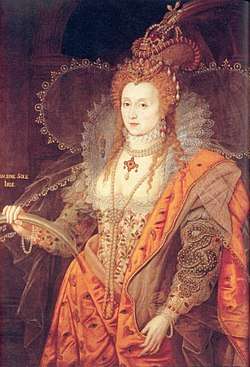Audrey Walsingham
Lady Audrey Walsingham (née Shelton; 1568–1624) was an English courtier. She served as Lady of the Bedchamber to queen Elizabeth I of England, and then as Mistress of the Robes to Anne of Denmark from 1603 until 1619.
Family connections
Sometimes called "Etheldreda", she was born on 10 June 1568 to Sir Ralph Shelton of Shelton, Norfolk and Mary Woodhouse, daughter of William Woodhouse of Waxham. Her mother died five days after her birth.[1]
Her father was a son of Sir John Shelton and Margaret Parker, daughter of the heir to Henry, Lord Morley. John Shelton's mother was Anne Shelton née Boleyn, aunt of Anne Boleyn, Henry VIII's queen, and his sisters included Madge Shelton and Mary Shelton. Her aunt Mary Shelton married Sir John Scudamore.
Audrey Shelton married Sir Thomas Walsingham, cousin of Sir Francis Walsingham. Their home was Scadbury Manor at Chislehurst.

Lady of the Bedchamber to Elizabeth
She served as Lady of the Bedchamber to Queen Elizabeth.
In 1600 the Earl of Northumberland presented Elizabeth with a petticoat supplied by Lady Walsingham and a jewel bought from John Spilman, the total value of his gift was £200.[2]
During Thomas Egerton's entertainment at Harefield Entertainment in August 1602, she was assigned in the lottery the prize of a cutwork stomacher in the lottery with these verses; "This stomacher is full of windows wrought, Yet none through them can look into your thought."[3] Walsingham presented the queen with Egerton's gift of a gown or robe embroidered with rainbows and recited verses about Iris and St Swithin.[4] The historian Janet Arnold linked this presentation at Harefield with the "Rainbow" portrait of Elizabeth at Hatfield House.[5] The embroidery depicted in the portrait has some similarities with the contemporary petticoat formerly preserved at St Faith's Bacton, Herefordshire.[6]
Mistress of the Robes to Anne
In 1603, Walsingham was selected by the Privy Council to join an English entourage sent to meet the new queen Anne of Denmark at the Scottish border, and accompany her to London. Her companions included the Countess of Kildare and the Countess of Worcester. At first the queen was reluctant to make Walsingham and Kildare ladies of her Privy Chamber, but preferred Lucy Russell, Countess of Bedford.[7] Lady Anne Clifford noted that she was a great favourite of Sir Robert Cecil at this time.[8]
She was appointed Mistress of the Robes on 26 July 1603 by Anna of Denmark, and given a salary of 40 marks yearly. The role including buying "stuffs of gold, silver, tinsel, silk", and appointing tailors and embroiderers for the queen's apparel.[9]
Anne asked Walsingham and the Countess of Suffolk to take Elizabeth's old clothes from a store in the Tower of London for a masque at Christmas 1603.[10] She participated in the masques organised by queen Anne, and played the role of Astraea in The Vision of the Twelve Goddesses (1604), and Periphere in Masque of Blackness (1605).
In May 1606 she was paid £300 towards the supply of linen for Anne of Denmark during childbed and for the use of Princess Mary.[11] One of her servants died at Hampton Court in October 1606 during plague scare.[12]
Anne of Denmark gave her presents of her old clothes, on 6 January 1611 she received a velvet gown with stripes of cloth of gold and gold lace.[13]
She was rumored to have a relationship with Robert Cecil (d. 1612), and in the anonymous poem O Ladies, Ladies Howle & Cry she was accused of having caused his death together with the Countess of Suffolk by infecting him with syphilis.
In August 1615 thieves took embroidered cushion and stool covers and sewing silk for embroidery weighing 40 pounds from Whitehall Palace said to belong to her husband, but may have been connected with the queen's wardrobe.[14]
The court physician Théodore de Mayerne noted she suffered from serious headaches or migraine.[15]
She died in May 1624 and was buried at St Nicholas, Chislehurst.
References
- Carole Levin, Anna Riehl Bertolet: A Biographical Encyclopedia of Early Modern Englishwomen: Exemplary Lives and Memorable Acts, 1500-1650, New York, 2017
- Leeds Barroll, Anna of Denmark, Queen of England: A Cultural Biography
- 'O Ladies, ladies howle & cry', Early Stuart Libels.
- Francis Blomefield, An Essay Towards a Topographical History of the County of Norfolk, vol. 5 (London, 1806), p. 268.
- HMC 6th Report: Northumberland (London, 1879), p. 228.
- Elizabeth Goldring, Faith Eales, Elizabeth Clarke, Jayne Elisabeth Archer, John Nichols's The Progresses and Public Processions of Queen Elizabeth, vol. 4 (Oxford, 2014), pp. 184-6, 190 modernised here.
- John Nichols, The Progresses and Public Processions of Queen Elizabeth, vol. 3 (London, 1823), pp. 15-16, 591-3.
- Janet Arnold, Queen Elizabeth's Wardrobe Unlocked (London, 1988), pp. 83-4, 94.
- Eleri Lynn, 'The Bacton Altar Cloth', Costume, 52:1 (March 2018), pp. 18-20.
- Edmund Lodge, Illustrations of British History, vol. 3 (London, 1838), pp. 11-12.
- Jessica L. Malay, Anne Clifford's Autobiographical Writings (Manchester, 2018), p.19.
- Mary Anne Everett Green, CSP Domestic: Addenda: 1580-1625 (London, 1872), p. 427, TNA SP15/35 f.61.
- Sara Jayne Steen, The letters of Lady Arbella Stuart (Oxford, 1994), p. 197.
- Frederick Madden, Issues of the Exchequer (London, 1836), pp. 34-5.
- A. B. Hinds, HMC Downshire, vol. 2 (London, 1936), p. 439.
- Jemma Field, 'The Wardrobe Goods of Anna of Denmark', Costume, 51:1 (March 2017), p. 20, and Supplement p. 45 no. 391.
- Constance Brown Kuriyama, Christopher Marlowe: A Renaissance Life (Cornell, 2002), p. 101 quoting Middlesex Court Records, vol. 2, p. 100.
- Henry Ellis, Original Letters, 2nd series vol. 3 (London, 1827), p. 247.
| Court offices | ||
|---|---|---|
| Preceded by Dorothy Stafford |
Mistress of the Robes to the Queen 1603–1619 |
Succeeded by Susan Feilding, Countess of Denbigh |